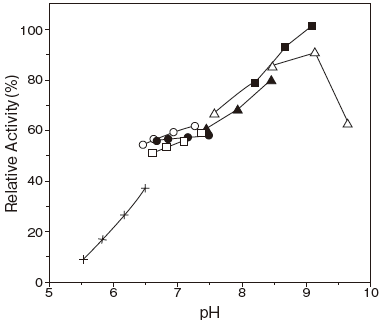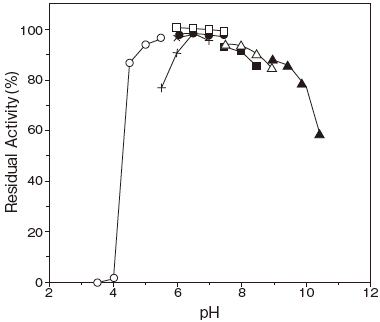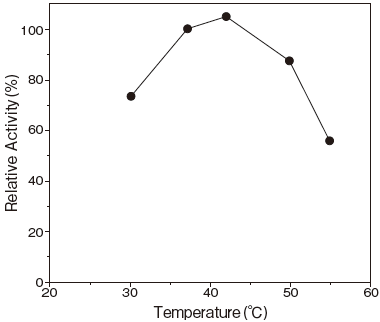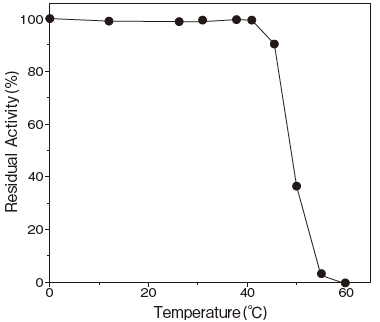(Diagnostic Reagent Grade) Nagase Diagnostics ENZYMES T-107REACH適合品
L–α–GLYCEROPHOSPHATE OXIDASE [GPOM]
from Streptococcus sp.
(sn–Glycerol–3–phosphate: oxygen 2–oxidoreductase, EC 1. 1. 3. 21)
L–α–Glycerophosphate + O2 → Dihydroxyacetone phosphate + H2O2
Preparation and Specification
- Appearance
- : Yellowish amorphous powder, lyophilized
- Specific activity
- : More than 15.0 U/mg solid
Properties
- Substrate specificity
- : See Table 1
- Molecular weight
- : 169 kDa (TSK gel G 3000 SW XL gel filtration)
65 kDa (SDS–PAGE)
- Isoelectric point
- : pH 4.4
- Michaelis constants
- : L–α–Glycerophosphate 0.64 mM (pH 7.5)
- Optimum pH
- : 8.5–9.0Figure 1
- pH stability
- : 6.0–8.0 (37℃, 30 min) Figure 2
- Optimum temperature
- : 37–42℃ (pH 6.5) Figure3
- Thermal stability
- : Stable at 40℃ and below (pH 6.5) Figure4
- Effect of metal ions
- : See Table 2
- Effect of detergents
- : See Table 3
- tabilizers
- : FAD
Applications for Diagnostic Test
This enzyme is useful for enzymatic determination of triglyceride.
| LP | ||
| TG + 3 H2O | → | Glycerol + 3 Fatty acid |
| GKZ | ||
| Glycerol + ATP | → | G-3-P + ADP |
| GPOM | ||
| G-3-P + O2 | → | DHAP + H2O2 |
| POD | ||
| 2 H2O2 + 4-AA + Phenol | → | Quinoneimine dye + 4 H2O |
TG: Triglyceride, DHAP: Dihydroxyacetone phosphate
Table 1. Substrate specificity
| Substrate (300mM) | Relative activity (%) |
|---|---|
| L–α–Glycerophosphate | 100 |
| Glucose–1–phosphate | 0 |
| Glucose–6–phosphate | 0 |
| Glycerol | 0 |
| Glucose | 0 |
Table 3. Effect of detergents on GPOM activity
| Detergent (0.1%) | Relative activity (%) |
|---|---|
| None | 100 |
| EMULGEN 810 | 98 |
| EMULGEN 911 | 98 |
| RHEODOL TWL–106 | 99 |
| RHEODOL 460 | 99 |
| ADEKANOL NP–720 | 99 |
| Triton X–100 | 98 |
| Triton X–305 | 99 |
| Tween 80 | 98 |
Table 2. Effect of metal ion on GPOM activity
| Metal ion (2mM) | Relative activity (%) |
|---|---|
| None | 100 |
| MgCl2 | 101 |
| MgSO4 | 102 |
| ZnCl2 | 102 |
| ZnSO4 | 102 |
| NaCl | 103 |
| NH4Cl | 103 |
| BaCl2 | 103 |
| Ba (CH3COO) 2 | 101 |
| NiCl2 | 103 |
| CoCl2 | 103 |
| MnCl2 | 114 |
| LiCl | 103 |
| KCl | 102 |
| CaCl2 | 103 |
Fig.1 Optimum pH

200 mM buffer
〇: MES buffer
●: PIPES buffer
□: Phosphate buffer
■: Tris buffer
△: DEA buffer
▲: TEA buffer
+: Citrate buffer
〇: MES buffer
●: PIPES buffer
□: Phosphate buffer
■: Tris buffer
△: DEA buffer
▲: TEA buffer
+: Citrate buffer
Fig.2 pH Stability

37℃, 30 min.
200 mM buffer
〇: Citrate buffer
●: PIPES buffer
□: Phosphate buffer
■: Tris buffer
△: DEA buffer
▲: Glycine buffer
+: MES buffer
-: Bis Tris buffer
200 mM buffer
〇: Citrate buffer
●: PIPES buffer
□: Phosphate buffer
■: Tris buffer
△: DEA buffer
▲: Glycine buffer
+: MES buffer
-: Bis Tris buffer
Fig.3 Optimum Temperature

pH 6.5
200 mM PIPES buffer
200 mM PIPES buffer
Fig.4 Thermal Stability

pH 6.5, 10min.
50 mM PIPES buffer
50 mM PIPES buffer
Assay
Principle
The assay is based on the increase in absorbance at 600 nm as the formation of quinoneimine dye in the following reactions:
| GPOM | ||
| L–α–Glycerophosphate+O2 | → | Dihydroxyacetone phosphate+H2O2 |
| POD | ||
| 2 H2O2+4–AA+DAOS | → | Quinoneimine dye+4H2O |
DAOS : [3,5–dimethoxy–N–ethyl–N– (2–hydroxy–3– sulphopropyl) aniline]
Unit definition
One unit is defined as the amount of enzyme which generates 1 μmole of H2O2 per minute at 37℃ under the conditions specified in the assay procedure.
Reagents
- Reaction mixture
Dissolve 6.05 g of PIPES and 9.45 g (purity calculation) of Disodium Glycerophosphate with 70 ml of distilled water and adjust pH to 6.5 with 4 N NaOH at 25℃. Add all reagents listed below and confirm pH is 6.5 at 25℃.
Add distilled water to make a total of 100 ml.100 U/ml POD 1) solution 5.0 ml 15 mM 4–AA solution 10.0 ml
100mM DAOS solution 1.0 ml 5% (W/V) Triton X–100 solution 1.0 ml 1) : 100 U/ml POD solution Dissolve 1,000 U (PPU) of POD with 10 ml of distilled water. - Reaction stopper
0.5% (W/V) SDS solution
SDS: Sodium dodecyl sulfate - Enzyme dilution buffer
10 mM PIPES–NaOH buffer pH 6.5
containing 0.1% (W/V) Triton X–100 - Reagents
PIPES [Piperazine–1,4,–bis (2–ethanesulfonic acid) ]:Dojindo Laboratories # 345–02225DAOS (sodium salt) : Dojindo Laboratories #OC06
4–AA: NACALAI TESQUE, INC.Special grade #01907–52Triton X–100: The Dow Chemical Company
Disodium Glycerophosphate 5.5 Hydrate :FUJIFILM Wako Pure Chemical CorporationSDS (Sodium Dodecyl Sulfate) :
#192–02055NACALAI TESQUE, INC. Extra pure #31606–75POD: Sigma Chemical Co. Type Ⅱ #P–8250
Enzyme solution
- Accurately weigh about 20 mg of the sample and add enzyme dilution buffer to make a total of 20ml. Dilute it with enzyme dilution buffer to adjust the concentration as required.
Procedure
- Pipette accurately 1.0 ml of reaction mixture into a
small test tube and preincubate at 37℃. - After 5 min, add exactly 20 μl of enzyme solution and mix to start the reaction at 37℃.
※ In the case of a test blank, add 20 μl of enzyme dilution buffer in place of enzyme solution. - At 5 min after starting the reaction, add 2.0 ml of the
- reaction stopper to stop the reaction.
- Measure the absorbance at 600 nm.
0.1 Abs ≦ △A (As−Ab) ≦ 0.2 AbsAbsorbance sample : As blank : Ab
Calculation
Activity (U/mg of powder) = {(△ A/5)/(16.8×1/2)} × 3.02/0.02 × 1/x| 16.8 : | millimolar extinction coefficient of quinoneimine dye at 600 nm ( cm2 /μmole) |
| 1/2 : | a multiplier derived from the fact that 2 mole of H2O2 produces l mole of quinoneimine dye |
| 5 : | reaction time (min) |
| 3.02 : | final volume (ml) |
| 0.02 : | volume of enzyme solution (ml) |
| X : | concentration of the sample in enzyme solution ( mg/ml) |
Storage
Storage at −20℃ in the presence of a desiccant is recommended. Enzyme activity will be retained for at least one year under this condition.
References
- Jacobs, N. J. and Van Demark, P. J. (1960) Arch.
Biochem. Biophys., 88, 250–255. - Koditschek, L. K. and Umbreit, W. W. (1969) J. Bacteriol., 98, 1063–1068.
- Gancedo, C., Gancedo, J. M. and Sols, A. (1968) J. Biochem. ( Tokyo) , 5, 165–172.
- Kistler, W. S., Hirsch, C. A., Cozzarelli, N. R. and Lin, E. C. C. (1969) J. Bacteriol., 100, 1133–1135.
- Esders, T. W. and Michrina, C. A. (1979) J. Biol. Chem., 254, 2710–2715.
GPOM 活性測定法 (Japanese)
試薬液
- 反応試薬混合液
PIPES 6.05g とグリセロりん酸2Na 9.45g (純度換算) を精製水70ml に溶解した後、4N NaOH でpH6.5 (25℃) に調整し、その液に下記試薬を加えて混和し、pH6.5 (25℃) であることを確認した後、精製水で全容100ml とする。100U/ml POD 溶液1) 5.0 ml 15mM 4–AA 溶液 10.0 ml 100mM DAOS 溶液 1.0 ml 5% (W/V) トリトンX–100 溶液 1.0 ml 1) : 100U/ml POD 溶液
POD 1,000 単位 (PPU) を精製水10ml で溶解する。
- 反応停止液
0.5% (W/V) SDS 溶液 - 酵素溶解希釈用液
0 . 1 % ( W / V ) トリトン X – 1 0 0 を含む1 0 m M
PIPES–NaOH 緩衝液 pH6.5 - 試薬
PIPES[ピペラジン–1,4–ビス (2–エタンスルホン酸) ]:同仁化学製 #345–02225
DAOS[3,5–ジメトキシ–N–エチル–N– (2–ヒドロキ
シ–3–スルフォプロピル) アニリン]:同仁化学製 #OC064–AA:ナカライテスク製 特級 #01907–52
トリトンX–100:Dow Chemical 製
グリセロりん酸二ナトリウム5.5 水和物:富士フイルム和光純薬製 #192–02055SDS (ドデシル硫酸ナトリウム) :ナカライテスク製 一級 #31606–75POD:シグマ製 Type Ⅱ #P–8250
酵素試料液
- 検品約20mg を精密に量り、酵素溶解希釈用液で溶解して全容20ml とする。
その液を酵素溶解希釈用液で適宜希釈する。
測定操作法
- 小試験管に反応試薬混合液1.0ml を正確に分注し、37℃で予備加温する。
- 5 分経過後、酵素試料液20 μl を正確に加えて混和し、37℃で反応を開始する。
※ 盲検は酵素試料液の代わりに酵素溶解希釈用液
20 μl を加える。 - 5 分経過後、反応停止液2.0ml を加えて混和し、反応を停止する。
- 600nm における吸光度を測定する。
求められた吸光度を試料液はAs、盲検液はAb とする。
0.1 Abs ≦ ΔA = (As−Ab) ≦ 0.2 Abs
計算
- 以下の計算式に従い、活性 (U/mg) を計算する。
活性 (U/mg) = {(△A/5)/(16.8×1/2)} × 3.02/0.02 × 1/x
16.8 : キノンイミン色素の600nm におけるミリモル分子吸光係数 (cm2 / μmole)1/2 : H2O2 2 モルからキノン色素1 モルが生成することによる係数 5 : 反応時間 (min) 3.02 : 反応総液量 (ml) 0.02 : 反応に供した酵素試料液量 (ml) X : 酵素試料液中の検品濃度 (mg/ml)
